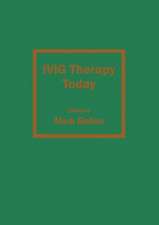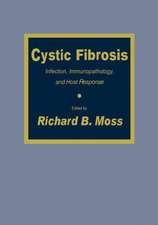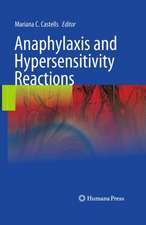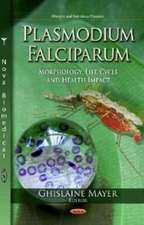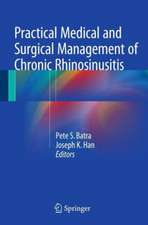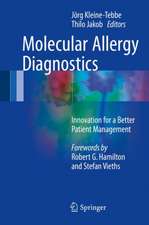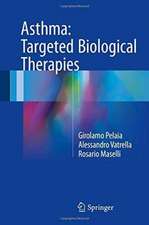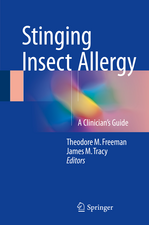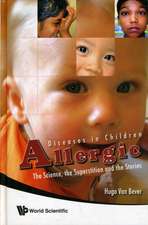National Institute of Allergy and Infectious Diseases, NIH: Volume 1: Frontiers in Research: Infectious Disease
Editat de Vassil St. Georgiev, Karl Western, John J. McGowanen Limba Engleză Hardback – 23 iun 2008
Extensive and in-depth, National Institute of Allergy and Infectious Diseases, NIH: Volume 1, Frontiers in Research is a valuable, comprehensive guide to the state of research today.
| Toate formatele și edițiile | Preț | Express |
|---|---|---|
| Paperback (1) | 2136.03 lei 6-8 săpt. | |
| Humana Press Inc. – 19 noi 2010 | 2136.03 lei 6-8 săpt. | |
| Hardback (1) | 2038.58 lei 38-44 zile | |
| Humana Press Inc. – 23 iun 2008 | 2038.58 lei 38-44 zile |
Din seria Infectious Disease
- 5%
 Preț: 1435.28 lei
Preț: 1435.28 lei - 5%
 Preț: 1430.35 lei
Preț: 1430.35 lei - 18%
 Preț: 723.51 lei
Preț: 723.51 lei - 5%
 Preț: 801.13 lei
Preț: 801.13 lei - 5%
 Preț: 683.00 lei
Preț: 683.00 lei - 5%
 Preț: 1110.72 lei
Preț: 1110.72 lei - 5%
 Preț: 1094.25 lei
Preț: 1094.25 lei - 5%
 Preț: 1414.80 lei
Preț: 1414.80 lei - 5%
 Preț: 1101.37 lei
Preț: 1101.37 lei - 5%
 Preț: 790.88 lei
Preț: 790.88 lei - 5%
 Preț: 1027.12 lei
Preț: 1027.12 lei - 5%
 Preț: 1364.19 lei
Preț: 1364.19 lei - 18%
 Preț: 1280.72 lei
Preț: 1280.72 lei - 18%
 Preț: 944.99 lei
Preț: 944.99 lei - 5%
 Preț: 1414.29 lei
Preț: 1414.29 lei - 5%
 Preț: 1113.99 lei
Preț: 1113.99 lei - 5%
 Preț: 1431.81 lei
Preț: 1431.81 lei - 5%
 Preț: 1121.69 lei
Preț: 1121.69 lei - 5%
 Preț: 1117.65 lei
Preț: 1117.65 lei - 5%
 Preț: 1612.30 lei
Preț: 1612.30 lei - 5%
 Preț: 723.05 lei
Preț: 723.05 lei - 18%
 Preț: 1253.42 lei
Preț: 1253.42 lei - 5%
 Preț: 1321.68 lei
Preț: 1321.68 lei - 5%
 Preț: 1427.62 lei
Preț: 1427.62 lei - 5%
 Preț: 725.03 lei
Preț: 725.03 lei - 5%
 Preț: 712.60 lei
Preț: 712.60 lei
Preț: 2038.58 lei
Preț vechi: 2145.86 lei
-5% Nou
Puncte Express: 3058
Preț estimativ în valută:
390.07€ • 408.37$ • 322.77£
390.07€ • 408.37$ • 322.77£
Carte tipărită la comandă
Livrare economică 01-07 aprilie
Preluare comenzi: 021 569.72.76
Specificații
ISBN-13: 9781934115770
ISBN-10: 1934115770
Pagini: 457
Ilustrații: XVIII, 530 p. 207 illus., 92 illus. in color.
Dimensiuni: 210 x 279 x 33 mm
Greutate: 1.95 kg
Ediția:2008
Editura: Humana Press Inc.
Colecția Humana
Seria Infectious Disease
Locul publicării:Totowa, NJ, United States
ISBN-10: 1934115770
Pagini: 457
Ilustrații: XVIII, 530 p. 207 illus., 92 illus. in color.
Dimensiuni: 210 x 279 x 33 mm
Greutate: 1.95 kg
Ediția:2008
Editura: Humana Press Inc.
Colecția Humana
Seria Infectious Disease
Locul publicării:Totowa, NJ, United States
Public țintă
ResearchCuprins
National Institute of Allergy and Infectious Diseases (NIAID): An Overview.- Microbiology and Infectious Diseases.- Biotools for Determining the Genetics of Susceptibility to Infectious Diseases and Expediting Research Translation Into Effective Countermeasures.- Spore Surface Components and Protective Immunity to Bacillus anthracis.- New Candidate Anthrax Pathogenic Factors.- Ehrlichiae and Ehrlichioses: Pathogenesis and Vector Biology.- Multiple Locus Variable Number Tandem Repeat (VNTR) Analysis (MLVA) of Brucella spp. Identifies Species-Specific Markers and Insights into Phylogenetic Relationships.- Expression of the MtrC-MtrD-MtrE Efflux Pump in Neisseria gonorrhoeae and Bacterial Survival in the Presence of Antimicrobials.- What can Mycobacteriophages Tell Us About Mycobacterium tuberculosis?.- Clinical Mycobacterium tuberculosis Strains Differ in their Intracellular Growth in Human Macrophages.- Mechanisms of Latent Tuberculosis: Dormancy and Resuscitation of Mycobacterium tuberculosis.- Separating Latent and Acute Disease in the Diagnosis of Tuberculosis.- Mutant Selection Window Hypothesis: A Framework for Anti-mutant Dosing of Antimicrobial Agents.- The NIAID Influenza Genome Sequencing Project.- Lessons From the 1918 Spanish Flu Epidemic in Iceland.- Control of Notifiable Avian Influenza Infections in Poultry.- Understanding the Complex Pathobiology of High Pathogenicity Avian Influenza Viruses in Birds.- Development of Prophylactics and Therapeutics Against the Smallpox and Monkeypox Biothreat Agents.- The Hierarchic Informational Technology for QSAR Investigations: Molecular Design of Antiviral Compounds.- Antivirals for Influenza: Novel Agents and Approaches.- Anti-Infectious Actions of Proteolysis Inhibitor ?-Aminocaproic Acid (?-ACA).- A New HighlyPotent Antienteroviral Compound.- Reduction and Possible Mechanisms of Evolution of the Bacterial Genomes.- Interaction of Yersinia pestis Virulence Factors with IL-1R/TLR Recognition System.- IS481-Induced Variability of Bordetella pertussis.- Microarray Immunophosphorescence Technology for the Detection of Infectious Pathogens.- Development of Immunodiagnostic Kits and Vaccines for Bacterial Infections.- Research in Emerging and Re-emerging Diseases in Central Asia and the Caucasus: Contributions by the National Institute of Allergy and Infectious Diseases and the National Institutes of Health.- Disease Surveillance in Georgia: Benefits of International Cooperation.- Epidemiology (Including Molecular Epidemiology) of HIV, Hepatitis B and C in Georgia: Experience From U.S.—Georgian Collaboration.- The National Tuberculosis Program in the Country of Georgia: An Overview.- Human Immunodeficiency Virus and Aids.- Virus Receptor Wars: Entry Molecules Used for and Against Viruses Associated with AIDS.- HIV Latency and Reactivation: The Early Years.- HIV-1 Sequence Diversity as a Window Into HIV-1 Biology.- Human Monoclonal Antibodies Against HIV and Emerging Viruses.- Biological Basis and Clinical Significance of HIV Resistance to Antiviral Drugs.- NIAID HIV/AIDS Prevention Research.- Epidemiological Surveillance of HIV and AIDS in Lithuania.- Immunology and Vaccines.- TACI, Isotype Switching, CVID, and IgAD.- A Tapestry of Immunotherapeutic Fusion Proteins: From Signal Conversion to Auto-stimulation.- A Role for Complement System in Mobilization and Homing of Hematopoietic Stem/Progenitor Cells.- Post-translational Processing of Human Interferon- ? Produced in Escherichia coli and Approaches for its Prevention.- B-cell Dysfunctions in Autoimmune Diseases.- A ModelSystem for Studying Mechanisms of B-cell Transformation in Systemic Autoimmunity.- Breach and Restoration of B-cell Tolerance in Human Systemic Lupus Erythematosus (SLE).- Dendritic Cells: Biological and Pathological Aspects.- Immunomic and Bioinformatics Analysis of Host Immunity in the Vaccinia Virus and Influenza A Systems.- Immunoreactions to Hantaviruses.- Innate Immunity to Mouse Cytomegalovirus.- Research and Development of Chimeric Flavivirus Vaccines.- Correlates of Immunity Elicited by Live Yersinia pestis Vaccine.- Building a Sustainable Personal Research Portfolio.- Strategies for a Competitive Research Career.- Selecting the Appropriate Funding Mechanism.- Preparing and Submitting a Competitive Grant Application.- Identifying Research Resources and Funding Opportunities.
Recenzii
From the reviews:
"This introduction to the structure, activities, and mission of the NIAID includes a section on building a sustainable research career. … The book is intended for students and early career biomedical researchers … . Useful introductory and career planning sections help readers understand the NIH and the grant writing process." (Kari A. Simonsen, Doody’s Review Services, January, 2009)
"This introduction to the structure, activities, and mission of the NIAID includes a section on building a sustainable research career. … The book is intended for students and early career biomedical researchers … . Useful introductory and career planning sections help readers understand the NIH and the grant writing process." (Kari A. Simonsen, Doody’s Review Services, January, 2009)
Textul de pe ultima copertă
For over 50 years, the mission of the National Institute of Allergy and Infectious Diseases (NIAID) has been to conduct and support basic and applied research to better understand, treat, and prevent infectious, immunologic, and allergic diseases with the ultimate goal of improving the health of individuals in the United States and around the world. As part of its mission to foster biomedical discovery and to reduce the burden of human disease, NIAID is committed to encouraging the accelerated translation of biomedical discoveries into effective clinical care and public health practice throughout the world. In pursuit of this goal and its disease-specific scientific objectives, NIAID seeks to broaden research opportunities and collaborations involving scientists and institutions outside the United States.
National Institute of Allergy and Infectious Diseases, NIH: Volume 1, Frontiers in Research contains presentations given at the 2006 NIAID Research Conference held in Opatija, Croatia which brought internationally known researchers from the United States and Central and Eastern Europe to focus together on shared interests in microbiology, infectious disease, HIV/AIDS, and basic and clinical immunology. Some of the topics covered include emerging and re-emerging infections, the development of infectious disease prophylactics and therapeutics, drug resistance, and various topics in immunomodulation, autoimmunity, infections and immunity, and the development of vaccines.
Extensive and in-depth, National Institute of Allergy and Infectious Diseases, NIH: Volume 1, Frontiers in Research is a valuable, comprehensive guide to the state of research today.
National Institute of Allergy and Infectious Diseases, NIH: Volume 1, Frontiers in Research contains presentations given at the 2006 NIAID Research Conference held in Opatija, Croatia which brought internationally known researchers from the United States and Central and Eastern Europe to focus together on shared interests in microbiology, infectious disease, HIV/AIDS, and basic and clinical immunology. Some of the topics covered include emerging and re-emerging infections, the development of infectious disease prophylactics and therapeutics, drug resistance, and various topics in immunomodulation, autoimmunity, infections and immunity, and the development of vaccines.
Extensive and in-depth, National Institute of Allergy and Infectious Diseases, NIH: Volume 1, Frontiers in Research is a valuable, comprehensive guide to the state of research today.
Caracteristici
Includes up-to-date accounts of specific research endeavor presented at the 2006 NIAID Research Conference Contains a detailed overview of the NIH/NIAID mechanisms of research funding of grant applications Explains the management of grants, technology transfer, and bioethical issues Includes supplementary material: sn.pub/extras






